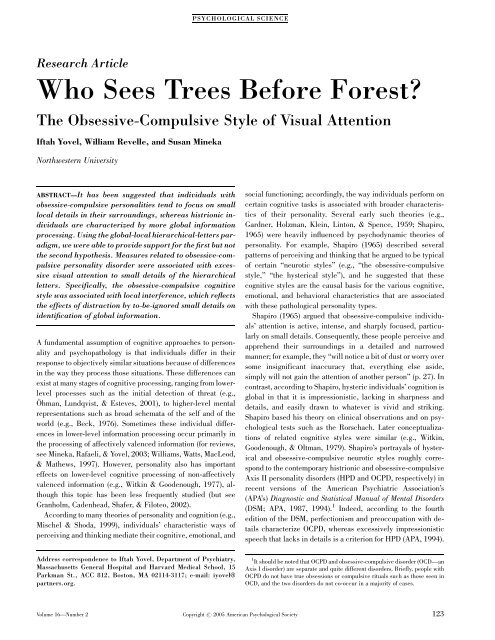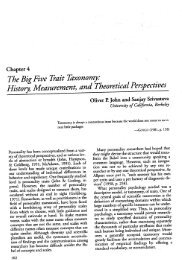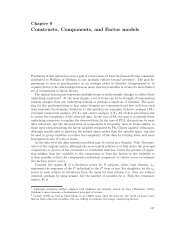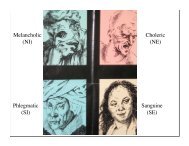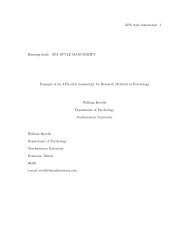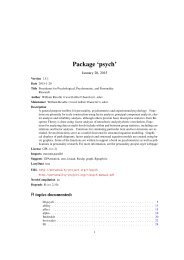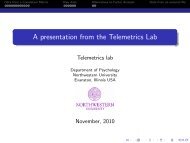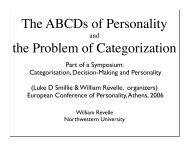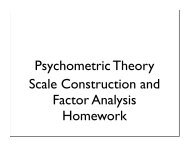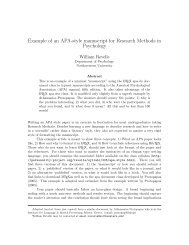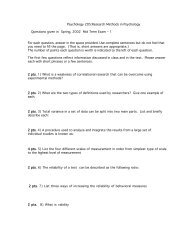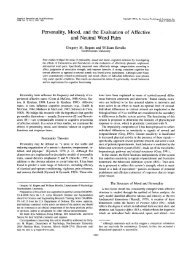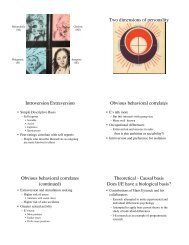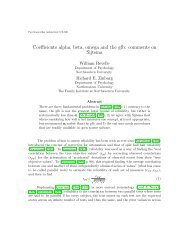Who Sees Trees Before Forest? - The Personality Project
Who Sees Trees Before Forest? - The Personality Project
Who Sees Trees Before Forest? - The Personality Project
You also want an ePaper? Increase the reach of your titles
YUMPU automatically turns print PDFs into web optimized ePapers that Google loves.
PSYCHOLOGICAL SCIENCEResearch Article<strong>Who</strong> <strong>Sees</strong> <strong>Trees</strong> <strong>Before</strong> <strong>Forest</strong>?<strong>The</strong> Obsessive-Compulsive Style of Visual AttentionIftah Yovel, William Revelle, and Susan MinekaNorthwestern UniversityABSTRACT—It has been suggested that individuals withobsessive-compulsive personalities tend to focus on smalllocal details in their surroundings, whereas histrionic individualsare characterized by more global informationprocessing. Using the global-local hierarchical-letters paradigm,we were able to provide support for the first but notthe second hypothesis. Measures related to obsessive-compulsivepersonality disorder were associated with excessivevisual attention to small details of the hierarchicalletters. Specifically, the obsessive-compulsive cognitivestyle was associated with local interference, which reflectsthe effects of distraction by to-be-ignored small details onidentification of global information.A fundamental assumption of cognitive approaches to personalityand psychopathology is that individuals differ in theirresponse to objectively similar situations because of differencesin the way they process those situations. <strong>The</strong>se differences canexist at many stages of cognitive processing, ranging from lowerlevelprocesses such as the initial detection of threat (e.g.,Öhman, Lundqvist, & Esteves, 2001), to higher-level mentalrepresentations such as broad schemata of the self and of theworld (e.g., Beck, 1976). Sometimes these individual differencesin lower-level information processing occur primarily inthe processing of affectively valenced information (for reviews,see Mineka, Rafaeli, & Yovel, 2003; Williams, Watts, MacLeod,& Mathews, 1997). However, personality also has importanteffects on lower-level cognitive processing of non-affectivelyvalenced information (e.g., Witkin & Goodenough, 1977), althoughthis topic has been less frequently studied (but seeGranholm, Cadenhead, Shafer, & Filoteo, 2002).According to many theories of personality and cognition (e.g.,Mischel & Shoda, 1999), individuals’ characteristic ways ofperceiving and thinking mediate their cognitive, emotional, andsocial functioning; accordingly, the way individuals perform oncertain cognitive tasks is associated with broader characteristicsof their personality. Several early such theories (e.g.,Gardner, Holzman, Klein, Linton, & Spence, 1959; Shapiro,1965) were heavily influenced by psychodynamic theories ofpersonality. For example, Shapiro (1965) described severalpatterns of perceiving and thinking that he argued to be typicalof certain ‘‘neurotic styles’’ (e.g., ‘‘the obsessive-compulsivestyle,’’ ‘‘the hysterical style’’), and he suggested that thesecognitive styles are the causal basis for the various cognitive,emotional, and behavioral characteristics that are associatedwith these pathological personality types.Shapiro (1965) argued that obsessive-compulsive individuals’attention is active, intense, and sharply focused, particularlyon small details. Consequently, these people perceive andapprehend their surroundings in a detailed and narrowedmanner; for example, they ‘‘will notice a bit of dust or worry oversome insignificant inaccuracy that, everything else aside,simply will not gain the attention of another person’’ (p. 27). Incontrast, according to Shapiro, hysteric individuals’ cognition isglobal in that it is impressionistic, lacking in sharpness anddetails, and easily drawn to whatever is vivid and striking.Shapiro based his theory on clinical observations and on psychologicaltests such as the Rorschach. Later conceptualizationsof related cognitive styles were similar (e.g., Witkin,Goodenough, & Oltman, 1979). Shapiro’s portrayals of hystericaland obsessive-compulsive neurotic styles roughly correspondto the contemporary histrionic and obsessive-compulsiveAxis II personality disorders (HPD and OCPD, respectively) inrecent versions of the American Psychiatric Association’s(APA’s) Diagnostic and Statistical Manual of Mental Disorders(DSM; APA, 1987, 1994). 1 Indeed, according to the fourthedition of the DSM, perfectionism and preoccupation with detailscharacterize OCPD, whereas excessively impressionisticspeech that lacks in details is a criterion for HPD (APA, 1994).Address correspondence to Iftah Yovel, Department of Psychiatry,Massachusetts General Hospital and Harvard Medical School, 15Parkman St., ACC 812, Boston, MA 02114-3117; e-mail: iyovel@partners.org.1 It should be noted that OCPD and obsessive-compulsive disorder (OCD—anAxis I disorder) are separate and quite different disorders. Briefly, people withOCPD do not have true obsessions or compulsive rituals such as those seen inOCD, and the two disorders do not co-occur in a majority of cases.Volume 16—Number 2 Copyright r 2005 American Psychological Society123
<strong>The</strong> Obsessive-Compulsive Cognitive Style<strong>The</strong> current study examined the basic features of attentiondescribed in Shapiro’s (1965) characterizations of the obsessive-compulsiveand the histrionic cognitive styles. To do this,we used Navon’s (1977) now-classic global-local paradigm forthe study of hierarchical visual attention, which seems to offeran appropriate operationalization of these cognitive characteristics(i.e., global vs. local visual attention). <strong>The</strong> basic assumptionthat underlies the global-local paradigm is that anyvisual scene can be thought of as composed of a hierarchicalnetwork of subscenes that are interrelated by spatial relationships(Kimchi, 1992). <strong>The</strong> globality of any of these subscenesdepends on the place it occupies in this hierarchy. Thus,properties at higher levels are more global than those at lowerlevels, which are in turn more local. For example, a car hassome global properties (e.g., shape, color), but it also has somelocal components (e.g., wheels, a license plate), each of whichcan be considered global in relation to its own component parts(e.g., the figures on the license plate).Navon’s (1977) global-local paradigm addresses this issue inan elegant way (for a review, see Kimchi, 1992). <strong>The</strong> stimuli inthis paradigm are figures (e.g., letters) that are constructed bysuitable displays of smaller figures. <strong>The</strong> two types of figures inthese hierarchical stimuli are equally complicated and identifiable,and neither can be predicted by the characteristics ofthe other (see Fig. 1a). <strong>The</strong> bigger and smaller figures differ intheir relative size, but more important, they differ in theirglobality, or their relative placement in the aforementionedhierarchy (Navon, 1977). Thus, the larger figure is the globallevel of the hierarchical stimulus, whereas the smaller figuresare its local level.In the focused-attention global-local task used in the currentstudy (based on Navon, 1977, Experiment 3), participants wereasked to focus their attention on one of the levels (global orlocal) of each of a series of hierarchical letters and to decide oneach trial which of the two target letters (H or T) was present inthat prespecified level (e.g., the global), while ignoring the otherlevel (e.g., the local). Thus, the task included two parts; for eachpart, only one level of the stimuli (i.e., the global or the local)was relevant. For example, in the global part of the task, thecorrect response for a big H made of small Ts was ‘‘H,’’ whereasin the local part, the correct response for this same stimulus was‘‘T.’’ In each part, three types of stimuli were used (see Fig. 1a): aconsistent type, in which the same target letter appeared at boththe global and the local levels; an inconsistent type, in whichdifferent target letters appeared at the two levels; and a neutraltype, in which the unattended level (e.g., local in the global partof the task) was not a target letter.Two well-established attentional effects are typically reportedwith this task (Kimchi, 1992; Fig. 1b illustrates these effects).First, participants identify the letter more rapidly when theglobal rather than the local level is relevant. This is the globalprecedenceeffect. Second, when the two levels of the hierarchicalstimulus are inconsistent and the local level is relevant, aFig. 1. Examples of the stimuli (a) and average response latencies (b) inthe six conditions of the global-local task. <strong>The</strong> target letter was always TorH. In the consistent and inconsistent conditions, the stimuli were the samefor the global and local conditions. In the neutral condition, the stimuli forthe global and local conditions differed, as shown. Stimuli are not drawnto scale. <strong>The</strong> three attentional effects of interest are labeled in the graph ofreaction times. <strong>The</strong>se indices were used in the correlational analyses examiningthe relation between the personality measures and attention toglobal and local visual information.robust Stroop-like influence of the global on the local level istypically found (Kimchi, 1992). This is the global-interferenceeffect. Both effects reflect that the global level is more salientthan the local level—that the ‘‘forest’’ is more salient than the‘‘trees.’’ <strong>The</strong>refore, both effects seem directly related to Shapiro’s(1965) histrionic global cognitive style and inversely relatedto the obsessive-compulsive cognitive style (see Dickman,1985; Maynard & Meyer, 1996).A third attentional effect that is sometimes reported inthe global-local task is the local-interference effect, which is theStroop-like effect that occurs when participants attend to theglobal level of the hierarchical stimuli but are distracted by thesmall inconsistent letters at the unattended local level. Althoughthe magnitude of this effect depends on certain featuresof the task (e.g., the relative salience of the two levels; cf. Yovel,Yovel, & Levy, 2001), it is typically smaller than the magnitudeof the global-precedence and global-interference effects.124 Volume 16—Number 2
Iftah Yovel, William Revelle, and Susan Mineka<strong>The</strong>refore, this effect has rarely been reported in cognitive experiments,which usually study a relatively small number ofparticipants (but see Paquet & Merikle, 1984). Nevertheless,the phenomenon that the local-interference effect measures, theextent to which local small details of stimuli (the trees) interferewith the processing of their global aspect (the forest), seemsdirectly related to Shapiro’s (1965) obsessive-compulsive cognitivestyle.<strong>The</strong> effects observed with the global-local paradigm havebeen previously linked to several personality traits (e.g., Compton& Weissman, 2002; Granholm et al., 2002). For example,Granholm and his colleagues (2002) recently showed thatschizotypal personality disorder is associated with globalprocessing advantage. However, as far as we know, only Dickman(1985) and Maynard and Meyer (1996) specifically examinedShapiro’s (1965) obsessive and histrionic cognitivestyles using this paradigm. Both these studies used speededcard-sorting versions of the focused-attention global-local task,but neither supported Shapiro’s hypotheses. One possible explanationis that the card-sorting version of the global-local taskwas simply not sensitive enough to detect the personality-relatedeffects, and another possibility is that one or both ofShapiro’s hypotheses is incorrect. However, a third possibility isthat both these studies failed to detect the obsessive-compulsivestyle of visual perception because they examined only the morerobust global-precedence and global-interference effects, butnot the local-interference effect, which better operationalizesthis style of visual perception.Why are the global-precedence and global-interference effectsnonideal measures of the obsessive-compulsive style? Onereason is that they are assessed at least in part during the localphase of the task, when participants are being asked to attend tothe local level of the hierarchical stimuli. It is possible that theattention of obsessive individuals is easily drawn to small details,so compared with other people, they identify the smallletters more quickly but also tend to dwell on these details for alonger period of time before responding. Thus, the obsessivecompulsivecognitive style may be associated with both speededand slowed responses to local information that cancel eachother out. This issue becomes irrelevant during the global phaseof the task, when the task is to identify the global big letter.Under these conditions, any process that may result from enhancedattention to the to-be-ignored small letters will increasethe magnitude of interference. Thus, the local-interferenceeffect can be regarded as an unambiguous measure of the detailorientedobsessive-compulsive style of visual attention. Similarly,the global-interference effect, which is measured whenparticipants need to attend to the small local letters and ignorethe big letter, is the clearest operationalization of the globalhistrionic cognitive style. According to this logic, the globalprecedenceeffect, which is based on performance on both theglobal and the local phases of the task, is not the optimalmeasure of either cognitive style. Thus, we predicted that scoreson OCPD-related scales would correlate with the local-interferenceeffect, and that scores on HPD-related scales mightcorrelate with the global-interference effect.<strong>The</strong> personality measures we used were taken from theSchedule for Nonadaptive and Adaptive <strong>Personality</strong> (SNAP;Clark, 1993), which is a self-report inventory designed to assessmaladaptive traits that are relevant to DSM personality disorders.<strong>The</strong> SNAP seemed particularly suitable for the currentcorrelational investigation in a nonclinical population becauseit is based on a dimensional approach that assumes a continuumbetween normal and abnormal personality. <strong>The</strong> reliability andvalidity of the SNAP have been confirmed in both clinical andnonclinical populations (e.g., Clark, 1993; Morey et al., 2003).For example, a recent study that examined the relationshipsbetween the traits measured by the SNAP and the symptomatologyof several personality disorders (including OCPD) in alarge group of patients showed that the SNAP scales were significantlyrelated to structured-interview-based diagnoses ofthese disorders (Morey et al., 2003). Furthermore, these scaleswere able to distinguish patients diagnosed with these disordersfrom several comparison groups, including patients with otherpersonality disorders, depressed patients, and nonclinical individuals.On the basis of these findings, Morey and his colleaguessuggested that individuals with OCPD can be portrayedas perfectionists and workaholics and that HPD is associatedprimarily with exhibitionism.METHODParticipantsParticipants were 89 (56 females) undergraduate students atNorthwestern University who participated in the study as part oftheir research participation requirement. Ten participants wereexcluded from the data analyses because of high error rates(n 5 5) or extreme index scores (n 5 5) in the cognitive tasks(see details in Results). All the analyses were based on theremaining 79 participants.<strong>Personality</strong> Measures<strong>The</strong> SNAP (Clark, 1993; Clark, Vorhies, & McEwen, 2002) is a375-item self-report inventory designed to assess maladaptivetraits that are related to personality disorders in the revisedthird edition of the DSM (DSM-III-R). <strong>The</strong> SNAP includes traitscales and diagnostic scales. Both types of scales show adequatelevels of internal consistency and test-retest reliability inclinical and in nonclinical populations (Clark, 1993; Moreyet al., 2003).<strong>The</strong> SNAP trait scales assess primary trait dimensions relevantto Axis II personality disorders (Clark, 1993; Clark et al.,2002). In this study, five SNAP trait scales relevant to HPD andOCPD were administered (cf. Clark, 1993; Morey et al., 2003):Exhibitionism (relevant to HPD) contains 16 items and taps theVolume 16—Number 2 125
<strong>The</strong> Obsessive-Compulsive Cognitive Styledimension of overt attention seeking versus withdrawal from theattention of other people; Impulsivity (relevant to HPD and inverselyto OCPD) contains 19 items and reflects the tendency toact on a momentary basis, without an overall plan, versus thetendency to think and plan before acting; Entitlement (relevantto both HPD and OCPD in the same direction) contains 16 itemsand measures unrealistically positive self-regard and feelings ofbeing someone who should be treated as a special person;Propriety (relevant to OCPD) contains 20 items and measuresthe dimension of traditional, conservative morality versus rejectionof social rules and conventions; Workaholism (relevantto OCPD) contains 18 items and taps individual differences inthe tendency to perfectionism and self-driven motivation towardhard work and excellence versus the tendency to take a morerelaxed attitude toward work and accomplishments.<strong>The</strong> SNAP diagnostic scales are based on the criteria for theDSM-III-R Axis II personality disorders (APA, 1987), and eachcriterion of each disorder is measured by two or three items. TwoSNAP diagnostic scales were administered, the 20-item scalethat assesses HPD and the 23-item scale that measures OCPD.Clark (1993) reported that the correlations (r) of both thesescales with structured-interview-based clinical ratings of thesedisorders in a mixed patient sample were .53 and .57, respectively.For both personality disorders, no correlation with anyother SNAP scale or clinical rating score was higher. Thus, bothscales show adequate convergent and discriminant validity.A total of 107 items from the SNAP were administered in thecurrent study (some items are included in more than one scale).Apparatus<strong>The</strong> cognitive task was presented using a Macintosh Performacomputer and 14-in. monitor (60 Hz), running the PsyScopeprogram (version 1.1; Cohen, MacWhinney, Flatt, & Provost,1993). Responses were recorded through a button-pressingresponse apparatus (New Micros Inc., Dallas, TX).Procedure<strong>The</strong> first phase of the experiment was an individual session inwhich participants completed the computerized global-localtask. <strong>The</strong>y viewed the stimuli from a distance of 45 cm, whichwas controlled by a chin rest. <strong>The</strong> stimuli were black hierarchicalletters (i.e., big letters made out of suitable arrangementsof small letters; Navon, 1977) that appeared on a white background.Each of the small letters was about 3 mm wide (visualangle of 0.381) and 3.5 mm high (0.451), and the big letters wereabout 25 mm wide (3.181) and about 38 mm high (4.831).A two-choice response task that included two parts was used.In each part, participants were asked to focus their attention onone of the two possible levels of the hierarchical stimuli (i.e., theglobal or the local) while ignoring the other level. Three types ofstimuli were presented in each part of the task (see Fig. 1a): (a)In consistent stimuli, the same target letter (H or T) appeared atboth the global and the local levels; (b) in inconsistent stimuli,different target letters appeared at the global and the locallevels (i.e., the global letter was T and the local letters were Hsor vice versa); and (c) in neutral stimuli, the figures at the unattendedlevel (local in the global condition and global in thelocal condition) were not target letters but rectangular shapes.In the global part of the task, the neutral stimuli were a big Tanda big H made out of small rectangular shapes, and in the localpart of the task, the neutral stimuli were rectangles made out ofsmall Hs or small Ts. Thus, six different types of stimuli werepresented in each part of this task.Each trial commenced with a beep sound and a fixation crossthat appeared at the center of the screen for 500 ms. <strong>The</strong> fixationcross was immediately followed by the stimulus, which waspresented for 100 ms at one of four possible locations. <strong>The</strong>medial edges of the stimuli were 6 mm (0.761) above or belowthe horizontal midline and 12 mm (1.531) to the right or to theleft of the vertical midline. On each trial, participants needed toidentify the letter presented at the relevant level (e.g., global),while ignoring the other level (e.g., local), by pressing thesuitable response key.At the outset of each part of the task (global or local), participantsperformed 24 practice trials. <strong>The</strong> experimental phaseconsisted of 42 trials in each part (each of the six stimuli waspresented seven times). <strong>The</strong> order in which the stimuli werepresented and the order of the locations in which they appearedwere fully randomized within each part. <strong>The</strong> order of the globaland local parts of the task was counterbalanced across participants.In the second phase of the study (1–7 days later), participantscompleted the questionnaires in small groups of up to 15 participants.Afterward, they were thanked and debriefed.RESULTSAttentional Effects Across Participants<strong>The</strong> average reaction times (RTs) for the six conditions were thedependent measures. <strong>The</strong> mean error rate was 3.0%. <strong>The</strong> data of5 participants whose error rates exceeded 10% were excludedfrom the analyses. For all participants, only trials with correctresponses were included in the analyses. <strong>The</strong> first trial of eachpart of the task and RTs faster than 250 ms and slower than1,500 ms were excluded (approximately 0.5% of all trials;Ratcliff, 1993). All subsequent analyses were based on thesetrimmed means.Analyses across participants confirmed that the study replicatedthe well-established global-precedence effect (localneutral vs. global neutral), t(78) 5 11.90, p < .001, d 5 1.35,and the global-interference effect (local inconsistent vs. localneutral), t(78) 5 8.32, p < .001, d 5 0.94 (Navon, 1977; seeFig. 1b). In addition, because of the relatively large numberof participants, the smaller local-interference effect (i.e., slowerlatencies in the global inconsistent condition than in the126 Volume 16—Number 2
Iftah Yovel, William Revelle, and Susan Minekaglobal neutral condition) was significant, t(78) 5 5.71, p < .001,d 5 0.65.<strong>Personality</strong> and Cognitive PerformanceFor each participant, we computed three different indices. <strong>The</strong>global-precedence effect was the difference between the localneutral and global neutral conditions; the global-interferenceeffect was the difference between the local inconsistent andlocal neutral conditions; and the local-interference effect wasthe difference between the global inconsistent and globalneutral conditions (see Fig. 1b). In order to minimize the influenceof outliers on the correlational analyses, we excludedfrom the analyses 5 participants who had extreme index scores(i.e., more than 3 standard deviations from the average indexscore across participants).Results for the local-interference index supported Shapiro’s(1965) portrayal of the obsessive-compulsive cognitive style:This index correlated significantly with the SNAP diagnosticscale of OCPD (r 5 .33, p < .005, d 5 0.70; df 5 77 for allcorrelations). A closer examination of the correlation betweenthe OCPD scale and the local-interference index suggests thatthis relationship followed a linear trend across the entire rangeof OCPD scores (see Fig. 2). In addition, the local-interferenceindex correlated significantly with two of the SNAP trait scales:Workaholism (r 5 .27, p < .02, d 5 0.56) and Entitlement (r 5.32, p < .005, d 5 0.68). <strong>The</strong>se relationships between OCPDrelatedscales and the local-interference index indicate thatparticipants who scored highly on these personality measureswere particularly distracted by the small local details of thehierarchical letters when required to identify the big letters atthe global level. None of the scales correlated significantly withthe global-precedence or the global-interference index (seeTABLE 1Correlations Between the <strong>Personality</strong> Scales and AttentionalEffectsSNAPscaleGlobalprecedenceGlobalinterferenceLocalinterferenceHPD .06 .04 .19OCPD .16 .11 .33 nnEntitlement .07 .08 .32 nnExhibitionism .02 .08 .21Impulsivity .00 .06 .13Propriety .12 .11 .16Workaholism .15 .03 .27 nNote. SNAP 5 Schedule for Nonadaptive and Adaptive <strong>Personality</strong>; HPD 5histrionic personality disorder; OCPD 5 obsessive-compulsive personalitydisorder.np < .05, two-tailed. nn p < .005, two-tailed.Table 1). Moreover, the current results do not provide anysupport for the hypothesized histrionic cognitive style.Each personality disorder is defined in the DSM by a clusterof criteria that do not necessarily represent a meaningful andpsychometrically homogeneous construct (e.g., McCrae et al.,2001; Reynolds & Clark, 2001; Widiger & Frances, 2002). Inaddition, two studies have recently found that OCPD criteria areparticularly variable in terms of their diagnostic efficiencies(Farmer & Chapman, 2002; Grilo, in press). Thus, in order tobetter understand the sources of the predicted relationshipbetween the SNAP diagnostic scale of OCPD and the localinterferenceindex, we explored the relationships between thiscognitive index and the various DSM-III-R criteria for OCPD,each measured by two or three SNAP items. Three of the eightDSM-III-R criteria for OCPD correlated significantly with thelocal-interference index. Most interestingly, local interferencewas associated with the OCPD criterion that deals with excessiveperfectionism that interferes with task completion (r 5 .23,p < .05, d 5 0.47). This criterion shows the best diagnosticefficiency among OCPD criteria (Farmer & Chapman, 2002;Grilo, in press), and it is directly related to the distractionmeasured by the local-interference effect. In addition,local interference correlated with the third and the fourthDSM-III-R OCPD criteria, which are related to inflexibilityin delegating tasks to other individuals (r 5 .23, p < .05, d 50.47) and to excessive workaholism (r 5 .31, p < .01, d 5 0.65),respectively.DISCUSSIONFig. 2. Scatter plot depicting the correlation between score on the ObsessiveCompulsive <strong>Personality</strong> Disorder (OCPD) diagnostic scale andthe local-interference effect.<strong>Personality</strong> measures related to OCPD were associated withexcessive visual attention to small local aspects of stimuli.Using Navon’s (1977) global-local paradigm, we showed thathigher scores on OCPD-related scales were associated withlocal interference. In other words, obsessive participants wereparticularly distracted by the to-be-ignored local aspects ofVolume 16—Number 2 127
<strong>The</strong> Obsessive-Compulsive Cognitive Stylehierarchical stimuli (the small letters, or the trees) when tryingto identify their global aspects (the big letter, or forest). <strong>The</strong>sefindings provide the first empirical support for the detail-orientedobsessive-compulsive attentional style (Shapiro, 1965).In contrast, the current study failed to support Shapiro’s histrioniccognitive style because HPD-related measures were notassociated with global visual attention.Previous studies using the global-local paradigm may havefailed to provide support for the obsessive-compulsive cognitivestyle because they examined only the global-interference andglobal-precedence effects (Dickman, 1985; Maynard & Meyer,1996). However, the local-interference effect, which reflectsexcessive attention to details that interferes with task completion,seems to be the effect that is most directly and unambiguouslyrelated to the proposed obsessive-compulsive style.In contrast, none of the HPD-related scales correlated significantlywith any of the effects of the global-local task, particularlynot with the global-interference effect, even thoughthis effect seems to unambiguously operationalize the histrionicglobal information processing style. On a cautionary note, theseconclusions regarding both cognitive styles are limited tononclinical populations such as the one we examined. Scoringhigh on traits such as workaholism or perfectionism is not a signof any type of psychopathology, particularly not for collegestudents. In addition, the diagnostic scales for OCPD and HPDare not significantly correlated (r 5 .12, n.s.) and so should notbe regarded as opposite extremes of the same continuum (cf.McCrae et al., 2001; Reynolds & Clark, 2001). <strong>The</strong>refore, eventhough the present findings indicate that individuals who scorelow on OCPD-related measures are less distracted by smalllocal details of stimuli than individuals who score high on thesemeasures, the results fail to support the hypothesized globalstyle of visual attention that was suggested to characterize HPD.In conclusion, by using a well-established cognitive measureof hierarchical visual attention, we showed that OCPD-relatedtraits were associated with excessive visual attention to smalldetails. More research into global versus local informationprocessing in clinical populations may contribute to the understandingof the basic cognitive functions that characterizeboth Axis I (e.g., obsessive-compulsive disorder) and Axis II(e.g., OCPD) psychopathology (cf. Savage et al., 2000).Acknowledgments—We would like to thank Galit Yovel andSuzanne Pineles for their helpful comments, as well as MarjorieSharkey, Leah Vaughn, Sharon Fleishman, and Cynthia Ho, whohelped conduct the study.REFERENCESAmerican Psychiatric Association. (1987). Diagnostic and statisticalmanual of mental disorders (3rd ed., rev.). Washington, DC: Author.American Psychiatric Association. (1994). Diagnostic and statisticalmanual of mental disorders (4th ed.). Washington, DC: Author.Beck, A.T. (1976). Cognitive therapy and the emotional disorders. NewYork: International Universities Press.Clark, L.A. (1993). Schedule for Nonadaptive and Adaptive <strong>Personality</strong>:Manual for administration, scoring and interpretation. Minneapolis:University of Minnesota Press.Clark, L.A., Vorhies, L., & McEwen, J.L. (2002). <strong>Personality</strong> disordersymptomatology from the five-factor model perspective. In P.T.Costa, Jr., & T.A. Widiger (Eds.), <strong>Personality</strong> disorders and thefive-factor model of personality (2nd ed., pp. 125–147). Washington,DC: American Psychological Association.Cohen, J.D., MacWhinney, B., Flatt, M., & Provost, J. (1993). Psy-Scope: An interactive graphic system for designing and controllingexperiments in the psychology laboratory using Macintoshcomputers. Behavior Research Methods, Instruments, & Computers,25, 257–271.Compton, R.J., & Weissman, D.H. (2002). Hemispheric asymmetries inglobal-local perception: Effects of individual differences inneuroticism. Laterality, 7, 333–350.Dickman, S. (1985). Impulsivity and perception: Individual differencesin the processing of the local and global dimensionsof stimuli. Journal of <strong>Personality</strong> and Social Psychology, 48,133–149.Farmer, R.F., & Chapman, A.L. (2002). Evaluation of DSM-IV personalitydisorder criteria as assessed by the structured clinicalinterview for DSM-IV personality disorders. Comprehensive Psychiatry,43, 285–300.Gardner, R.W., Holzman, P.S., Klein, G.S., Linton, H.P., & Spence, D.P.(1959). Cognitive control: A study of individual consistencies incognitive behavior. Psychological Issues, 1(4), 1–186.Granholm, E., Cadenhead, K., Shafer, K.M., & Filoteo, J. (2002).Lateralized perceptual organization deficits on the global-localtask in schizotypal personality disorder. Journal of AbnormalPsychology, 111(1), 42–52.Grilo, C.M. (in press). Diagnostic efficiency of DSM-IV criteria forobsessive compulsive personality disorder in patients with bingeeating disorder. Behaviour Research and <strong>The</strong>rapy.Kimchi, R. (1992). Primacy of wholistic processing and global/localparadigm: A critical review. Psychological Bulletin, 112, 24–38.Maynard, R.E., & Meyer, G.E. (1996). Visual information processingwith obsessive-compulsive and hysteric personalities. <strong>Personality</strong>and Individual Differences, 20, 389–399.McCrae, R.R., Yang, J., Costa, P.T., Dai, X., Yao, S., Cai, T., & Gao, B.(2001). <strong>Personality</strong> profiles and the prediction of categoricalpersonality disorders. Journal of <strong>Personality</strong>, 69, 155–174.Mineka, S., Rafaeli, E., & Yovel, I. (2003). Cognitive biases in emotionaldisorders: Social-cognitive and information processingperspectives. In R. Davidson, H. Goldsmith, & K. Scherer (Eds.),Handbook of affective science (pp. 976–1009). London: OxfordUniversity Press.Mischel, W., & Shoda, Y. (1999). Integrating dispositions andprocessing dynamics within a unified theory of personality: <strong>The</strong>cognitive-affective personality system. In L.A. Pervin (Ed.),Handbook of personality: <strong>The</strong>ory and research (2nd ed., pp. 197–218). New York: Guilford Press.Morey, L.C., Warner, M.B., Shea, M., Gunderson, J.G., Sanislow, C.A.,Grilo, C., Skodol, A.E., & McGlashan, T.H. (2003). <strong>The</strong> representationof four personality disorders by the Schedule forNonadaptive and Adaptive <strong>Personality</strong> Dimensional Model of <strong>Personality</strong>.Psychological Assessment, 15, 326–332.Navon, D. (1977). <strong>Forest</strong> before trees: <strong>The</strong> precedence of global featuresin visual perception. Cognitive Psychology, 9, 353–383.128 Volume 16—Number 2
Iftah Yovel, William Revelle, and Susan MinekaÖhman, A., Lundqvist, D., & Esteves, F. (2001). <strong>The</strong> face in the crowdrevisited: A threat advantage with schematic stimuli. Journal of<strong>Personality</strong> and Social Psychology, 80, 381–396.Paquet, L., & Merikle, P.M. (1984). Global precedence: <strong>The</strong> effectof exposure duration. Canadian Journal of Psychology, 38(1),45–53.Ratcliff, R. (1993). Methods for dealing with reaction time outliers.Psychological Bulletin, 114, 510–532.Reynolds, S.K., & Clark, L.A. (2001). Predicting dimensions of personalitydisorder from domains and facets of the Five-FactorModel. Journal of <strong>Personality</strong>, 69, 199–222.Savage, C.R., Deckersbach, T., Wilhelm, S., Rauch, S.L., Baer, L.,Reid, T., & Jenike, M.A. (2000). Strategic processing and episodicmemory impairment in obsessive compulsive disorder. Neuropsychology,14(1), 141–151.Shapiro, D. (1965). Neurotic styles. New York: Basic Books.Widiger, T.A., & Frances, A.J. (2002). Toward a dimensional model forthe personality disorders. In P.T. Costa, Jr., & T.A. Widiger (Eds.),<strong>Personality</strong> disorders and the five-factor model of personality (2nded., pp. 23–44). Washington, DC: American Psychological Association.Williams, J.M.G., Watts, F.N., MacLeod, C., & Mathews, A. (1997).Cognitive psychology and emotional disorders (2nd ed.). Chichester,England: John Wiley & Sons.Witkin, H.A., & Goodenough, D.R. (1977). Field dependence andinterpersonal behavior. Psychological Bulletin, 84, 661–689.Witkin, H.A., Goodenough, D.R., & Oltman, P.K. (1979). Psychologicaldifferentiation: Current status. Journal of <strong>Personality</strong> and SocialPsychology, 37, 1127–1145.Yovel, G., Yovel, I., & Levy, J. (2001). Hemispheric asymmetries forglobal and local visual perception: Effects of stimulus and taskfactors. Journal of Experimental Psychology: Human Perceptionand Performance, 27, 1369–1385.(RECEIVED 1/13/04; REVISION ACCEPTED 2/27/04)Volume 16—Number 2 129


